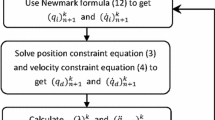Abstract
The real-time (RT) integration of the equations of motion describing complex mechanical systems requires the employment of proper integration schemes which must be able to handle the time integration at each time step in less than an a priori fixed sampling time interval. The linearly implicit Euler method has been successfully employed for the RT integration of large stiff differential algebraic systems of equations (DAEs) which typically arise from the complex mechanical systems of interest in practical applications. The current industry demand is to further increase the degree of complexity of multibody models employed in RT applications, pushing researchers to improve the efficiency of the currently available integration methods. In this paper, we investigate the improvements in the efficiency of the linearly implicit Euler method coming from the conversion of the equations of motion at each time step from a dependent to an independent coordinates’ formulation. The automatic switching from dependent to independent coordinates is achieved exploiting the properties of the matrix R whose columns represent a basis of the null-space of the constraint Jacobian matrix. A non-iterative projection method is also applied in order to avoid the drift-off from the constraint conditions.




Similar content being viewed by others
References
Eichberger, A., Rulka, W.: Process save reduction by macro joint approach: the key to real time and efficient vehicle simulation. Veh. Syst. Dyn. 41, 401–413 (2010)
Weber, S., Arnold, M.: Model reduction via quasistatic approximations. Proc. Appl. Math. Mech. 10, 655–656 (2010)
Burgermeister, B., Arnold, M., Eichberger, A.: Smooth velocity approximation for constrained systems in real-time simulation. Multibody Syst. Dyn. 26, 1–14 (2011)
Arnold, M., Burgermeister, B., Eichberger, A.: Linearly implicit time integration methods in real-time applications: DAEs and stiff ODEs. Multibody Syst. Dyn. 17, 99–107 (2007)
Burgermeister, B., Arnold, M., Esterl, B.: DAE time integration for real-time applications in multi-body dynamics. Z. Angew. Math. Mech. 86, 759–771 (2006)
Rill, G.: A modified implicit Euler algorithm for solving vehicle dynamic equations. Multibody Syst. Dyn. 15, 1–24 (2006)
Schiela, A., Bornemann, F.: Sparsing in real time simulation. Z. Angew. Math. Mech. 83, 637–647 (2003)
García de Jalón, J., Bayo, E.: Kinematic and Dynamic Simulation of Multibody Systems: The Real-Time Challenge. Springer, New York (1994)
Cuadrado, J., Cardenal, J.: Modeling and solution methods for efficient real-time simulation of multibody dynamics. Multibody Syst. Dyn. 1, 259–280 (1997)
Baumgarte, J.: Stabilization of constraints and integrals of motion in dynamical systems. Comput. Methods Appl. Mech. Eng. 1, 1–16 (1972)
Hairer, E., Wanner, G.: Solving Ordinary Differential Equations. II. Stiff and Differential-Algebraic Problems, 2nd edn. Springer, Berlin Heidelberg New York (1996)
Pennestrì, E., Valentini, P.P.: Coordinate reduction strategies in multibody dynamics: a review. In: Conference on Multibody System Dynamics, Pitesti, Romania, 25–26 October (2007). ISSN 1582-9561
Lubich, Ch., Engstler, Ch., Nowak, U., Pöhle, U.: Numerical integration of constrained mechanical systems using MEXX. Mech. Struct. Mach. 23, 473–495 (1995)
Pacejka, H.B.: Tire and Vehicle Dynamics, 2nd edn. Elsevier, Oxford (2006)
Lot, R., Da Lio, M.: A symbolic approach for automatic generation of the equations of motion of multibody systems. Multibody Syst. Dyn. 12, 147–172 (2004)
Prescott, B., Heirman, G., Furman, M., De Cuyper, J.: Using High-Fidelity Multibody Vehicle Models in Real-Time Simulations. SAE Technical Paper 2012-01-0927 (2012)
Acknowledgements
We gratefully acknowledge the European Commission (EC) for its support of the Marie Curie IAPP project 285808 “INTERACTIVE” (“Innovative Concept Modelling Techniques for Multi-Attribute Optimization of Active Vehicles”). Furthermore, we kindly acknowledge IWT Vlaanderen for its support of the ongoing research project “Model Driven Physical Systems Operation—MODRIO”, which is part of the ITEA2 project 11004 “MODRIO” (in turn, supported by the European Commission).
Author information
Authors and Affiliations
Corresponding author
Rights and permissions
About this article
Cite this article
Carpinelli, M., Gubitosa, M., Mundo, D. et al. Automated independent coordinates’ switching for the solution of stiff DAEs with the linearly implicit Euler method. Multibody Syst Dyn 36, 67–85 (2016). https://doi.org/10.1007/s11044-015-9455-x
Received:
Accepted:
Published:
Issue Date:
DOI: https://doi.org/10.1007/s11044-015-9455-x



